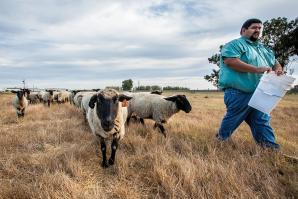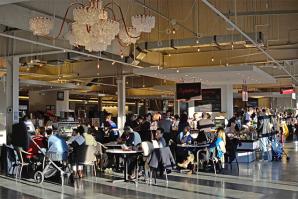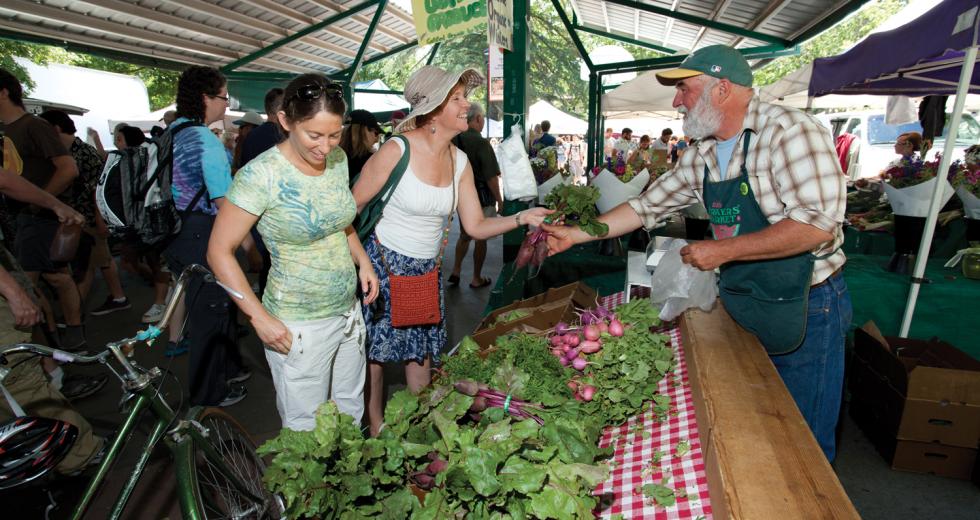It was the last farmer’s market of the season, and the photo-op recalled The Last Supper. Standing in Cesar Chavez Plaza, Mayor Kevin Johnson spread his arms behind two tables piled high with fresh fruits and vegetables. And with scores of white-aproned restaurateurs to his right and left, he unveiled a logo promoting Sacramento as an agronomical Eden.
“Everyone is always talking about what’s wrong with Sacramento, but this is the best of Sacramento,” exclaimed the mayor. “We are learning to play to our strengths.”
On that dewy day in October 2012, Sacramento officially became “America’s Farm-to-Fork Capital.”
The announcement kicked off an experiment to drive tourism by promoting Sacramento as a culinary destination. The Sacramento Convention and Visitor’s Bureau, which receives funding from the local hotel industry, is reaching out to national newspapers and magazines in an attempt to attract well-known food critics to publish favorable reviews. The city is also planning a weeklong event in the fall that will feature cowboys on horseback herding cattle down Capitol Mall. The idea behind the booster campaign is to capitalize on a growing social interest in fresh produce and small-scale farming. The operation has enjoyed widespread support from the agricultural community, though some have raised concerns about whether the effort will pay off.
Farm-to-fork is a catchphrase describing efforts to deliver local food to local consumers. It’s one branch of a sprawling foodie movement with many objectives, including supporting boutique farmers, lowering energy consumption and improving fresh food access to all.
Farm-to-fork also describes the practice of restaurants publicizing their use of locally grown foods. This is the component that first caught the eye of the visitor’s bureau: There is money to be made in this local food movement. There is also little doubt that marketing slogans can help raise a cities’ profile. In the 1990s, Las Vegas struggled to portray itself as a family destination, and marketers were at first reluctant to embrace the adult-themed “What happens here, stays here” motto. But the 2001 slogan is believed to have helped introduce Vegas to a new generation of sinners; tourism increased 5 percent over the following eight years.
Sacramento’s former marketing campaign for the city, “Discover Gold,” based largely on the region’s gold rush history, has found only limited appeal. The bureau is more optimistic this time.
“Not everybody is interested in the gold rush, not everybody is interested in the Kings, not everybody is interested in the history — but everybody eats. That to me is the really powerful piece,” says Mike Testa, senior vice president of the Sacramento Convention and Visitors Bureau.
But one doyenne of the California food movement is cautious. According to Darrell Corti, the 71-year-old manager of Corti Bros. grocery, the notion of farm-to-fork rejects contemporary American appetites and, if practiced in earnest, would require a dramatic shift in consumption patterns, especially in the winter months when crop offerings are limited. He worries that critics will use this fact to poke holes in Sacramento’s claim.
“It may come back and bite (the promoters) in the ass,” says Corti. “People have to understand that when you deal with the idea of farm to fork, you are dealing with Mother Nature.
“What happens if somebody comes in and says, ‘You guys say that you do all of these things, but you really don’t.’ And they start picking out the things and saying, ‘This isn’t from here, this isn’t from here.’ Then what?”
There is no single statistic that proves Sacramento leads the nation in delivering regionally grown food to local consumers — the technical definition of farm-to-fork. According to local government, the city consumes about 2 percent of the food grown in the surrounding region — 2 percent is the average of most cities, though the volume in Sacramento is higher because much more food is produced here. The six-county region also boasts 300 farms serving local markets, 40 farmer’s markets and at least 7,000 acres of boutique farms, though its unknown if those numbers set any national record.
Austin, Texas, coined the slogan “Live Music Capital of the World” in 1991 after the city realized it was home to more live music venues per capita than any other city. Beer enthusiasts have begun casually referring to San Diego as the craft beer capital of the U.S. after finding they have more breweries per capita than any other county (though it’s unclear if Austin and San Diego have ever independently verified their findings).
It is critical that Sacramento be able to back up its claim of being the farm-to-fork capital. The campaign involves bringing the city national exposure from food and travel writers of well-known media outlets. There have been some skeptical articles published in the pages of the Sacramento Bee, but a well-publicized national story declaring Sacramento’s movement undercooked could be a crusher.
Those supporting the slogan believe there is enough loosely affiliated agricultural activity occurring in the areas of production, research, education and sustainability to validate the statement. According to campaign architects, the initiative celebrates the region’s year-round yield of diverse crops. The slogan is also intended to encourage residents to increase local food consumption.
“That Webster’s definition of farm to fork doesn’t totally fit with this campaign,” acknowledges Testa. “It’s more of a broader term.”
Beyond the clear motivation of driving tourism dollars, the promoters also purport to see something else on the horizon — something outside Darrell Corti’s direct focus. It’s about giving locals something to say when an out-of-towner asks about life between Tahoe and San Francisco.
“We want people to like living in Sacramento,” says Testa. “We want them to tell their family in Idaho, ‘You should come visit. This is such a great city.’”
The campaign was conceived two years ago, when Gina Funk read an article predicting the pop culture spotlight on celebrity chefs would soon drift to celebrity farmers. Gina’s husband, Josh Nelson, co-founder of the Selland Family Restaurants, remarked that Sacramento is a perfect marriage of the two occupations, and he began working on a logo to play off the “I Love New York” slogan. When he came up with “I Dig Sacramento,” there was no grand plan. Nelson imagined the label pasted on t-shirts and sold at gift shops and his restaurants, which include The Kitchen and Ella Dining Room & Bar, two eateries with seasonal menus.
“It’s not unlike me to start doing something without purpose just because I have an idea,” says Nelson, who majored in marketing at Sac State.
The result was an image of a fork sprouting from the ground. Underneath the logo were the words “America’s Farm-to-Fork Capital.” As Nelson talked to friends and associates about the logo, he realized it had a greater potential, but he knew he had to move quickly before another city or company nabbed the phrase. There’s already a Farm to Fork Event Co. in Oregon and a nonprofit called Farm to Table that develops food policy in New Mexico.
Interesting aside: It isn’t unheard of for two groups to battle over a city tagline. In a highly publicized lawsuit that lasted nearly two years, Huntington Beach fought with a Santa Cruz surf shop over the rights to the phrase “Surf City USA.” In 2006, then-Santa Cruz Mayor Mike Rotkin performed a song suggesting the dispute be settled over a surf contest. Huntington Beach eventually prevailed through the courts, but a rivalry between the two beachfront towns continues to this day.
Nelson trademarked the “America’s Farm-to-Fork Capital” logo and bought several web addresses pertaining to it before donating them to the city. He also gathered statistics for the city’s official proclamation that Mayor Johnson unveiled at the October press event.
On a windy day in April, Mike Testa drove to a Woodland restaurant to bring his case to local farmers and the business community. “We are marketers, not farmers,” he said. “We need to validate this notion of farm to fork.”
Up until the 1960s, tomatoes could be found lining the streets of downtown Sacramento during the summer months, after having fallen from fruit trucks. Strawberries were grown between Fruitridge and Florin roads. Asparagus and corn were canned and packaged inside 20 major processing plants within the city.
It was economic, not social factors that pushed the food production out of the city. But Sacramento has a history of shying away from its reputation as a farm town — memorably, a 2003 proposal to paint the Interstate 5 water tower like a giant red tomato was reviled by city marketers fearing outside ridicule.
Regardless of whether the rest of the globe ever recognizes Sacramento as a farm-to-fork superpower, representatives of the agriculture sector report that the campaign is already bearing fruit. Since the city made its proclamation, the visitor’s bureau has been overwhelmed with calls and emails from farmers, chefs, educators, health advocates, nonprofits and local government. Supporters have begun hosting brainstorming sessions to find a unified voice for publicity and agriculture policy. The mood in Sacramento is up, says Tim Johnson, CEO of the California Rice Commission.
“Now there is this great recognition on the urban side of the value of agriculture,” he says. “This is an opportunity. Frankly, the walls have already been knocked down. The ag folks are sitting out in the parking lot going, ‘Wow, we can come in now. They want us.’”
Recommended For You

Rearing an Industry
How Solano County is cultivating its ag economy
Solano County is taking steps to develop a new agricultural hub that farmers and economists hope will someday house facilities to process raw ag products into purchasable commodities.

Sacramento Needs a Public Market
The Farm-to-Fork Capital is incomplete without one
Great food capitals of the world: Can you name them? Florence. Paris. Tokyo. Barcelona. Istanbul. Singapore. What do these destinations of culinary delights offer?



